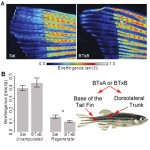September 23, 2014
Multi-disciplinary approach to understanding Botulinum toxin
 Research Associate Professor Werner Kaminsky contributed to a research project recently highlighted in Nature. With the catch phrase “BOTOX paralyses zebrafish muscles and blocks fin regeneration”, Nature highlighted a publication on the effect of Botulinum toxin on bone regeneration,[i] tested on small fish, whose fins were cut-off (under sedation), then regrown while testing different amounts of medications administrated to the fish’s dorsolateral trunk and the base of the tail fin prior to surgery.[ii] Nature summed up the findings with “muscle paralysis (was) similar to that seen in mammals and humans in that it was focal, dose-dependent and short-lasting.” and “BTx treatment had a negative impact on bone formation during fin regeneration.” The work involved a truly diverse multi-discipline co-operation between members of three departments on the UW campus: Orthopaedics and Sports Medicine, Pharmacology, and Chemistry. The regenerating zebrafish tail fin often provides a compelling model for therapeutic studies. However, a major hurdle to such efforts is the lack of quantitative modalities for bone mineralization analysis. Kaminsky contributed his patented microscopy technology to determine bone mineralization with a custom built automated polarized light microscope to sequentially acquire images under a stepwise rotating polarizer. This enabled birefringence to be decoupled from transmittance and orientation, allowing for quantitative analysis.
Research Associate Professor Werner Kaminsky contributed to a research project recently highlighted in Nature. With the catch phrase “BOTOX paralyses zebrafish muscles and blocks fin regeneration”, Nature highlighted a publication on the effect of Botulinum toxin on bone regeneration,[i] tested on small fish, whose fins were cut-off (under sedation), then regrown while testing different amounts of medications administrated to the fish’s dorsolateral trunk and the base of the tail fin prior to surgery.[ii] Nature summed up the findings with “muscle paralysis (was) similar to that seen in mammals and humans in that it was focal, dose-dependent and short-lasting.” and “BTx treatment had a negative impact on bone formation during fin regeneration.” The work involved a truly diverse multi-discipline co-operation between members of three departments on the UW campus: Orthopaedics and Sports Medicine, Pharmacology, and Chemistry. The regenerating zebrafish tail fin often provides a compelling model for therapeutic studies. However, a major hurdle to such efforts is the lack of quantitative modalities for bone mineralization analysis. Kaminsky contributed his patented microscopy technology to determine bone mineralization with a custom built automated polarized light microscope to sequentially acquire images under a stepwise rotating polarizer. This enabled birefringence to be decoupled from transmittance and orientation, allowing for quantitative analysis.
[ii]http://www.nature.com/bonekey/knowledgeenvironment/2014/140806/bonekey201463/full/bonekey201463.html